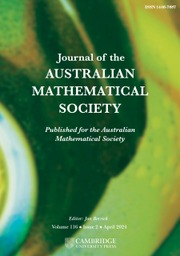No CrossRef data available.
Article contents
On non-isotropic homogeneous Lipschitz spaces
Published online by Cambridge University Press: 09 April 2009
Abstract
Core share and HTML view are not available for this content. However, as you have access to this content, a full PDF is available via the ‘Save PDF’ action button.
We prove that in a non-isotropic Euclidean space, homogeneous Lipschitz spaces of distributions, defined in terms of (generalized) Weierstrass integrals, can be characterized by means of higher order difference operators.
MSC classification
Information
- Type
- Research Article
- Information
- Copyright
- Copyright © Australian Mathematical Society 1989
References
[1]Cotlar, M. and Sadosky, C., ‘On quasi-homogeneous Bessel potential operators’, Proc. Sympos. Pure Math. 10 (1966), 275–287.Google Scholar
[2]Flett, T. M., ‘Temperatures, Bessel potential and Lipschitz spaces,’ Proc. London Math. Soc. 22 (1971), 385–207.Google Scholar
[3]Folland, G. B., ‘Subelliptic estimates and functions spaces on nilpotent Lie groups’, Ark. Math. 13 (1975), 161–207.Google Scholar
[4]Folland, G. B. and Stein, E. M., Hardy spaces on homogeneous groups, (Math. Notes 28, Princeton, 1982).Google Scholar
[5]Gaudry, G. I. and Pini, R., ‘Bernstein's theorem for compact connected Lie groups,’ Math. Proc. Cambridge Philos. Soc. 99 (1986), 297–305.Google Scholar
[6]Giulini, S., ‘Approximation and Besov spaces on stratified groups,’ Proc. Amer. Math. Soc. 96 (1986), 569–578.CrossRefGoogle Scholar
[7]Greenwald, H., ‘On the theory of homogeneous Lipschitz spaces and Campanato spaces,’ Pacific J. Math. 106 (1983), 87–93.Google Scholar
[8]Herz, C., ‘Lipschitz spaces and Bernstein's theorem on absolutely convergent Fourier transform,’ J. Math. Mech. 18 (1968), 283–323.Google Scholar
[9]Inglis, I. R., ‘Bernstein's theorem and the Fourier algebra of the Heisenberg group,’ Boll. Un. Mat. Ital. (VI) 2–A (1983), 39–46.Google Scholar
[10]Inglis, I. R., ‘Weak and strong mapping properties of translation invariant operators,’ Boll. Un. Mat. Ital. (VI) 1–B (1982), 523–533.Google Scholar
[11]Janson, S., ‘Generalizations of Lipschitz spaces and an application to Hardy spaces and bounded mean oscillation,’ Duke Math. J. 47 (1980), 959–982.CrossRefGoogle Scholar
[12]Janson, S., Taibleson, M. H. and Weiss, G., ‘Elementary characterizations of the MorreyCompanato spaces,’ Harmonic Analysis, edited by Mauceri, G., Ricci, F. and Weiss, G., pp. 101–104 (Lecture Notes in Mathematics 992, Springer-Verlag, 1983).CrossRefGoogle Scholar
[13]Johnson, R., ‘Temperatures, Riesz potentials and the Lipschitz spaces of Herz,’ Proc. London Math. Soc. 27 (1973), 290–316.CrossRefGoogle Scholar
[14]Krantz, S. G., ‘Geometric Lipschitz spaces and applications to complex function theory and nilpotent groups,’ J. Funct. Anal. 34 (1979), 456–471.Google Scholar
[15]Soardi, P. M., ‘On non-isotropic Lipschitz spaces,’ Harmonic Analysis, edited by Mauceri, G., Ricci, F. and Weiss, G., pp. 115–138 (Lecture Notes in Mathematics 992, Springer-Verlag, 1983).Google Scholar
[16]Stein, E. M., Singular Integrals and Differentiability Properties of Functions, (Princeton University Press, 1970).Google Scholar
[17]Stein, E. M. and Weiss, G., Introduction to Fourier Analysis on Euclidean Spaces, (Princeton University Press, 1971).Google Scholar
[18]Taibleson, M. H., ‘On the theory of Lipschitz spaces of distributions on Euclidean n-spaces, I’, J. Math. Mech. 13 (1964), 407–480.Google Scholar
[19]Taibleson, M. H., ‘On the theory of Lipschitz spaces of distributions on Euclidean n-spaces, II,’ J. Math. Mech. 14 (1965), 821–839.Google Scholar
[20]Torchinski, A., ‘Singular integrals in the space ∧(B, X),’ Studia Math. 48 (1973), 165–189.CrossRefGoogle Scholar

